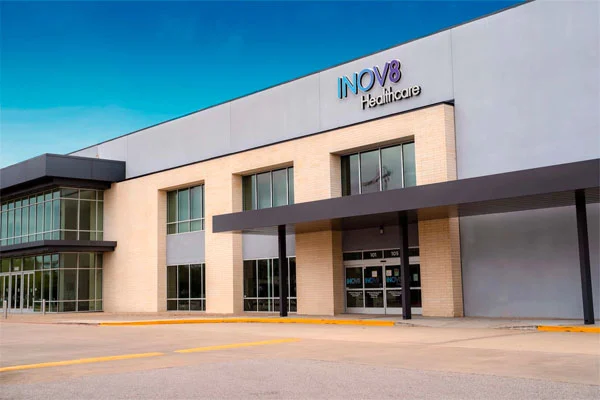Hip Procedures & Conditions
Houston, TX
At INOV8 Orthopedics in Houston, our surgeons have the expertise and experience necessary to perform advanced surgical interventions, including outpatient hip replacements. We incorporate the latest technology during surgery planning to improve patient outcomes and reduce recovery times. We also provide conservative treatment options when surgery can be avoided. Our experts rely on their cumulative decades of experience to devise custom treatment options for each patient.
Hip Bursitis
Also known as trochanteric bursitis, hip bursitis is simply inflammation of the bursa—a fluid-filled sac that prevents friction between tissues—in the hip. Hip bursitis is characterized by pain, reduced range of motion, and tenderness.
Common causes of hip bursitis are arthritis, a spinal abnormality, overuse, injury, or even surgery. Our top orthopedic group at INOV8 in Houston diagnoses hip bursitis with advanced imaging such as MRI or ultrasound. Hip bursitis is treated with a steroid injection into the affected location. If your bursa is infected, then our team must surgically drain and remove it.
Hip Synovitis
Hip synovitis is a condition which occurs in children and is caused by inflammation in the synovial tissues of the hip joint. These tissues surround the joint and will cause hip pain when inflamed. Hip synovitis typically occurs in children between two and nine years of age. Boys are much more likely to be affected than girls.
During your child’s consultation, our physician in Houston will conduct an exam of the hip and associated joints. If necessary, diagnostic tests such as an ultrasound or lab work will also be scheduled. Hip synovitis is usually treated with rest and anti-inflammatory medications.
AVN Avascular Necrosis
Avascular Necrosis (AVN) is a disease caused by a loss of blood supply to the bone. When this happens, bone tissue dies and the bone collapses.
There are many potential causes of AVN, such as injury, damage to blood vessels, or even long-term use of corticosteroids. In order to diagnose AVN, our team will use an MRI or a radionuclide bone scan.
The treatment plan for AVN will depend on your age, health, and the severity of your disease. Surgical interventions performed by our orthopedic team in Houston may include an osteotomy, which reshapes the damaged bone. Extreme cases require a total hip replacement.
Gluteus Medius Tear
The gluteus medius is located on the outer surface of the hip and is one of three buttocks muscles. The gluteus medius can tear (which many describe feeling like a “pulled butt muscle”) due to a degenerative condition or as the result of traumatic injury.
Minor gluteus medius tears are treated with rest, modifications to activity, anti-inflammatories, and ice. However, a full-thickness tear will likely require surgery. During surgery, our surgeons in Houston will debride (i.e., clean out) tears on the undersurface. They will also place anchors into the femur to reattach the tendon to its normal anatomic position.
Sometimes pain in the “glute muscle” is a gluteus medius strain and not a full tear. At INOV8 Orthopedics in Houston, we can provide an accurate diagnosis as well as the appropriate treatment.
Labral Tears of the Hip
The labrum is the soft tissue that covers the hip socket or acetabulum. Hip labral tears have various causes including injury, degenerative issues, or structural abnormalities. A hip labral tear may cause stiffness and pain and sometimes feels like a deep pain in the groin or in the buttocks. It can also feel like your hip is clicking or locking while in motion.
Minor hip labral tears can be treated with physical therapy and anti-inflammatory medications. At INOV8 Orthopedics, we always recommend the least invasive treatment. However, severe or complete tears require surgical intervention. During the procedure, our team will reconstruct your hip labrum using healthy tissue. The goal of the procedure is to restore movement and eliminate pain.
Chondral Injuries of the Hip
Chondral injuries occur when the articular cartilage in your hip joint is damaged. Some articular cartilage damage is normal with aging, but it can also be the result of various degenerative diseases. Chondral injuries are diagnosed with a physical exam and imaging.
Chondral injuries are typically treated with chondroplasty. During this procedure, our team debrides the damaged area. Another option is known as microfracture whereby our surgeon will drill tiny holes in the bone to encourage new cartilage growth.
Femoral Neck Fracture
Femoral neck fractures are one of the most common types of proximal femur fractures. The femoral neck is located just below the ball of your hip joint. While these injuries can occur in anyone, the risk of suffering a femoral neck fracture is highest in older adults. This is because aging causes a reduction in bone density.
Treatment for femoral neck fracture depends on whether or not blood supply is disrupted. If blood supply is disrupted, then you will likely need a total hip replacement. However, if blood flow is normal, then screws will be installed to stabilize the fracture.
Subtrochanteric Hip Fracture
Subtrochanteric hip fracture is a specific type of fracture classified by its location. The bone break can happen between the lesser trochanter and the area five centimeters below it. The lesser trochanter is a bony protrusion that projects from the lower and back part of the base of the femur neck.
If a patient is not well suited for surgical intervention, this type of fracture can be treated with traction. However, surgery remains the primary treatment option for this type of injury. During surgery, our professionals will utilize a plate and screws or nails to hold the fracture together.
Hip Dislocation
Hip dislocation is an injury to your joint. When the hip joint is dislocated, the bones of the femur and pelvis are forced out of their natural positions, which causes pain and immobilization in the joint.
Hip dislocations are most often caused by vehicle crashes. Often, hip dislocations are treated with physical therapy and non-invasive treatments. However, severe injuries may require surgery to reposition the hip and treat co-occurring conditions like a femoral neck fracture.
Arthritis of the Hip
The term “arthritis” simply refers to joint inflammation. Arthritis of the hip is inflammation specific to that joint. Mild forms of arthritis can be treated with lifestyle changes and anti-inflammatory medications. However, severe arthritis of the hip may require surgical intervention such as resurfacing or hip replacement.
Snapping Hip Syndrome
Snapping hip syndrome is a condition wherein you feel a snapping sensation or hear a popping sound in your hip during certain activities. It’s caused when a tendon or muscle glides over a bony protrusion in your hip.
Snapping hip syndrome is often diagnosed with a physical exam and imaging. It is generally treated with conservative methods. In rare cases, snapping hip syndrome may require surgical treatment via hip arthroscopy.
Schedule your Appointment
Use the form below to request an appointment.
INOV8 Orthopedics Location

Houston
10496 Katy Fwy Suite 101 Houston, TX 77043
Get Directions
(346) 571-7500
Monday – Friday 8:00am – 5:00pm

